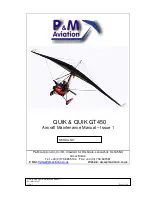
42
Section 7
Dangerous Situations and Extreme Flying
WARNING
Flying in extremely humid weather or in
rain is outside the operating limits of the
glider. If you are not able to avoid flying in
rain, please observe the following:
It is advisable to fly with slight
acceleration during and after the rain
(min. 30% or more)
Use no brake input or as little as
possible
Do not use big ears
Control travel reduces
Void tight turns, especially in the final
approach. If conditions allow, you
should also fly slightly accelerated in
this phase
Avoid large angles of attack and the
possible early stall near the ground
(release the speed bar only slowly)
Advertising and adhesives
Always make sure before attaching
advertising to the glider that the adhesive
’
behaviour. If you are in doubt, we
recommend that you do not attach the
adhesive.
PLEASE NOTE
Attaching adhesives to the glider which
are large, heavy, or made of unsuitable
material may result in revocation of the
certification.
Overloading
The glider structure is put under high levels
of strain in particular on extreme flight
manoeuvres, rapid descent methods (spiral
dives) or prohibited aerobatic manoeuvres.
They considerably accelerate the aging
process of the structure and should
therefore be avoided.
The glider must be inspected earlier than is
usually the case if it has been put under
more than the usual degree of strain.
Sand and salt air
In many cases, sand and salt air cause the
lines and fabric to age much more rapidly.
If you often fly near the sea, the glider
should be inspected more frequently than
normally required.
Temperature range
Temperatures below -10 °C and above
+50°C can make the paraglider unfit to fly.
T ’
glider is used outside of this temperature
range.
Summary of Contents for Powerplay Sting 2
Page 1: ...Version 1 0 Date 08 08 2014 Instruction Manual EN ...
Page 55: ...Notes ...













































